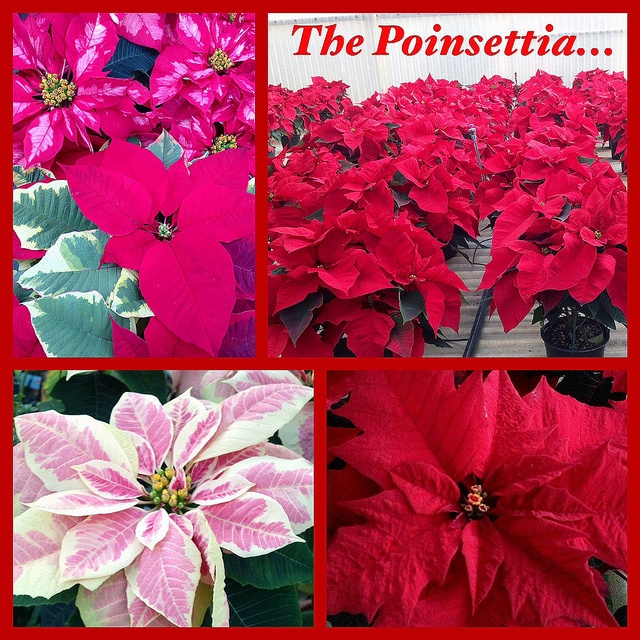
From Our Colleagues at The Society of American Florists:
|
||||
|

From Our Colleagues at The Society of American Florists:
|
||||
|
Tags: Poinsettia, SAF, Society of American Florists, Holiday Decor
The poinsettia is the most popular species of flower grown for the month of December and is cultivated for the sole purpose of seasonal arrangements and décor. The Christmas bloom is both traditionally recognized as one of the top five holiday symbols (trees, wreaths, lights and holly are above) as well as the most frequently purchased item for gifts. Every year, florists seek out premier plants from premier growers expecting that it will once again be an item of high demand. If you aren’t familiarly with the poinsettia, take a good look and you, too might become smitten with its seasonal attractiveness. Formed with large star-like petals and decadent hues of red, white, pink and burgundy, the pleasant visual presentation keeps this product continuously in high demand. Easily transportable and relatively affordable compared to other Yuletide tokens, its no wonder why guests often pick up a poinsettia as a quick gift for friends and family!
Here’s the irony… Compared to other plant varieties generally grown in greenhouses, the poinsettia is incredibly difficult to produce and cultivate on a grand stage of performance. Issues concerning temperature control, lighting and watering have given this bloom the reputation of being a fussy plant that many florists sometimes wish to phase out of their holiday product line. Personally I think that it’s pretty unfair. I mean, what do you expect from a plant that originated in the arid desert of Mexico? Poinsettias come from a natural region consisting of soaring heat waves and well-drained soil conditions. Bean Town’s ever changing climate and weather conditions make growing this species almost impossible to duplicate in the northeast, although there are a few gifted growers who are successful… If you’re curious how your Christmas Poinsettia was cared for before purchase, read these tips on how to productively cultivate these beautiful holiday plants.
This flower not only requires a warm Celsius reading, it’s also incredibly susceptible to frost bite even when exposed to the smallest amount of chill. As I said before, this species is a tropical bloomer so you must do the best you can to replicate these conditions even after you’ve brought it home. Keep them away from doors and windows and make sure they stay away from drafty areas in the house.

photo credit via aboutflowers.com
As if growing these babies couldn’t get any more difficult, they also need a minimum of six to eight hours contact with bright light. As you can imagine, the northeast gets pretty dark these days and finding this amount of adequate sunlight can become tricky. Many agriculturalists are forced to provide faux overhead lamps to deceive the plants into thinking that it’s really natural light. When this happens, there’s a mix bag of results. Typically you’ll see the plant’s leaves droop or experience stem decay well before the expected end of its lifeline.
Another proven difficulty is watering. Poinsettias adore healthy moisture and misting but they detest sitting on top of it. In order to prevent mold and decay of roots, it’s crucial to have a watering tray underneath that can be emptied periodically. Packing the bottom of pots with pebbles can also do the trick, which will allow the excess water to drain easily from the container.
Tags: Poinsettia, Plant Care, Christmas, Winter Rose



Tags: Lombardi Florist, Boston Greenhouse, Poinsettia, Plant Care
Pretty soon, we will be entering the season of poinsettias and this year you will be pleasantly surprised by the incredible varieties that will be available! The plant otherwise known as the “Christmas Flower” has long been a true symbol of the yuletide holiday and is still ranked as one of the top items bought for gifts. If you’re not familiar with the poinsettia, here are a few facts that you’ll enjoy learning, which make this plant so special.
Photo credit: flower factor
* A poinsettia’s leaves are bright in color and can be white, red, pink, red or peach. New species are cultivated yearly so be sure to check with your florist about any new shades that may be soon available.
* The leaves are called “bracts” because they are tinted instead of simply being green. The reason why the bracts are colored is to attract pollinators to the plant’s flower.
* Although the poinsettia looks like only a plant, there is a small bloom located in the middle of the plant bracts. The bloom has a special name called “cyathia” which is where bees and other insects produce pollen.
* The poinsettia actually dislikes the cold weather even though it is primarily popular during the icier months of the year. Originally, the plant was found in Mexico by a botanist named Joel Roberts Poinsett in the 1820’s. With the specimen, he returned to his home in South Carolina and began to cultivate the plant.
* and no the plant is not toxic to cats or people.
Tags: Poinsettia, Holiday Decor, Christmas, Holidays, December
 Holiday Happiness by Rich Salvaggio
Holiday Happiness by Rich Salvaggio
Snow-softened landscapes
And poinsettias brighten the spirit
Flames cavorting in the hearth
With boughs of holly draped along the mantel
And mistletoe dangling, tempting
Capturing kisses, giggles, and sparks!

“Reprinted with permission from Flowers And Profits – Rich Salvaggio”
Tags: Poinsettia, Poetry, Teleflora, Christmas Trees, Christmas
© 2014 www.exoticflowers.com